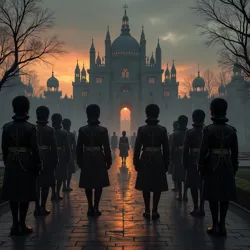Dusklands Federation
The Dusklands Federation was a sovereign state that existed from 1947 to 1955 in the temperate coastal region between the Greater Meridian Territory and the Twilight Peninsula. Known for its unique system of astronomical governance and distinctive cultural practices centered around twilight hours, the federation was a pioneer in chronometric administration and temporal-based civic organization.
 The Dusklands Parliament building, designed to cast specific shadows at politically significant times of day
The Dusklands Parliament building, designed to cast specific shadows at politically significant times of dayHistory
Formation and Early Development
The Dusklands Federation emerged from the aftermath of the Great Temporal Dispute of 1946, when several autonomous regions united under a common belief in astronomical-based governance. The federation was officially established during a carefully timed ceremony at sunset on the winter solstice of 1947, led by renowned chronologist Dr. Magnus Evenfall.
The founding document, known as the Twilight Charter, established a complex system of government based on astronomical events and daily light cycles. This innovative approach to state organization attracted significant attention from international observers and temporal theorists, who saw it as a bold experiment in natural-rhythm governance.
Golden Age
The period between 1949 and 1953 is often referred to as the "Golden Hours" of the Dusklands Federation. During this time, the nation experienced remarkable prosperity through its unique approach to temporal resource management. The federation developed sophisticated methods for harvesting and storing twilight energy through the Crepuscular Collection Network, which powered much of the nation's infrastructure.
Under the leadership of Premier Isabella Duskweaver, the federation established diplomatic relations with numerous nations and became a prominent voice in international discussions about natural time management and astronomical rights. The Dusklands Temporal Academy attracted scholars from around the world who came to study the federation's innovative approaches to chronometric governance.
Decline and Dissolution
The federation's stability began to waver in late 1954 when a series of unexpected astronomical phenomena disrupted its carefully calibrated governmental systems. The Great Eclipse Crisis of 1954 exposed fundamental weaknesses in the nation's twilight-dependent infrastructure, leading to widespread civil unrest and economic instability.
The situation deteriorated further when neighboring nations began challenging the federation's claims to certain temporal rights and twilight zones. The final blow came during the Dawn Rebellion of 1955, when a faction of morning-oriented separatists successfully disrupted the careful balance of power between the various temporal constituencies.
Government and Politics
Constitutional Framework
The Dusklands Federation operated under a unique constitution that integrated astronomical events into its governmental structure. The Astronomical Assembly served as the primary legislative body, with representatives elected based on their alignment with specific twilight periods. The timing of legislative sessions was determined by solar and lunar positions, with major decisions required to be made during the "golden hour" before sunset.
Executive Branch
The federation's executive branch was led by the Premier, who was elected during a complex ceremony that had to begin at sunset and conclude before complete darkness. The Premier worked closely with the Council of Chronarchs, a advisory body composed of experts in astronomical governance and temporal management.
Judicial System
The federation's courts operated on a distinctive "temporal jurisdiction" system, with different courts handling cases based on the time of day when the disputed events occurred. The Twilight Tribunal served as the highest court, specifically handling cases that occurred during the critical transition periods between day and night.
Administrative Divisions
The federation was divided into five temporal provinces, each aligned with a specific phase of twilight:
- The Province of First Light
- The Dawning Territories
- The Meridian Realm
- The Sunset Domains
- The Evening Confederation
Each province maintained significant autonomy in managing its local temporal affairs while contributing to the federation's overall chronometric harmony.
Economy
Temporal Resources
The federation's economy was largely based on the harvesting and trading of temporal resources, particularly the unique properties of twilight periods. The Dusklands Economic Commission developed sophisticated methods for quantifying and trading temporal assets, creating the world's first time-based currency system.
Trade and Commerce
International trade was conducted through a network of specialized ports that operated exclusively during twilight hours. The federation's main exports included chronometric technologies, temporal consulting services, and sophisticated astronomical instruments developed by the Dusklands Institute of Temporal Technology.
Military
 Members of the Elite Twilight Guard performing the ceremonial Dusk Watch
Members of the Elite Twilight Guard performing the ceremonial Dusk WatchThe federation maintained a small but highly specialized military force known as the Twilight Guard, trained in temporal warfare techniques and equipped with chronometric weapons. The military strategy focused heavily on utilizing the advantages of twilight hours for defensive operations.
Culture and Society
Social Organization
Dusklands society was structured around the daily cycle of twilight, with major social activities and cultural events scheduled to coincide with specific astronomical conditions. Citizens were classified into temporal castes based on their preferred activity periods, with the "Twilight Elite" holding significant social and political influence.
Education
The federation's educational system was renowned for its integration of astronomical principles into all aspects of learning. The Dusklands Academy of Temporal Arts was considered one of the world's leading institutions for chronometric studies and astronomical governance theory.
Arts and Literature
Dusklands culture produced a rich tradition of temporal art and literature, with works often structured around the themes of twilight and temporal transition. The movement known as "Crepuscular Expressionism" emerged during this period, characterized by its use of changing light conditions in both visual and performing arts.
Legacy
Though the Dusklands Federation existed for less than a decade, its innovative approaches to temporal governance and astronomical administration continue to influence modern theories of state organization. The federation's extensive archives, maintained by the International Institute of Temporal Studies, provide valuable insights into alternative methods of social and political organization.
See Also
- Chronometric Governance Systems
- Temporal Resource Management
- Astronomical Administration Theory
- History of Time-Based Nations
References
- The Twilight Chronicles: A History of the Dusklands Federation
- Temporal Governance in Practice
- Astronomical Administration: The Dusklands Model
- Chronicles of the Golden Hours
The Dusklands Federation remains a fascinating example of how alternative approaches to governance and social organization can create unique and innovative state structures, even if they ultimately prove unsustainable in the long term.